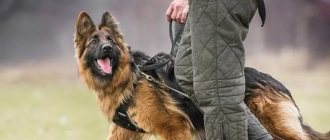Any training makes our dogs smarter and better. Moreover, it is necessary for the dog to become a decent member of society. However, teaching a pet everything is not easy. This requires a lot of time and patience: and, unfortunately, not everyone has that much free time from work. But you can’t give up on your pet. The solution is to choose at least a couple of types of training and teach your pet the basics. What types of training are there?
There are Russian, European and American standards for dog training. They are all good and it makes no sense to compare which one is better. But it's interesting to get to know the differences.
At what age should you train a dog?
Dog experts recommend starting basic skills training at 4 months of age. It was then that the baby had already received the required minimum of vaccinations and was ready to go outside. Dog handlers advise starting with simple commands that will allow you to control your pet on the street and in public places.
But the age of 3-4 months is called conditionally. For example, decorative dogs mature quite early. And by 4-6 months they enter the age category of teenagers. Therefore, their training can begin at the age of 2-3 months.
And representatives of large and giant breeds (Great Danes, Mastiffs, Alabais, Moscow Watchdogs, etc.) at the age of 4-6 months are completely stupid, albeit impressive-sized babies. Therefore, it is necessary to decide when the optimal time for training has come in each specific case.
You might be interested in our article: Raising a puppy. Where to start and how to succeed
This is important: There is an opinion that it is impossible to train an adult dog. In fact, this is completely wrong. Training an adult animal requires more persistence and patience. But 99.9% of dogs can be taught basic commands even in adulthood.
Army cynology - how to serve with your dog
Not for the first time, there have been rumors among conscripts that soon it will be possible to join the army with a dog. Indeed, it happens that there is simply no one to leave a four-legged friend with: if a young man is a pupil of an orphanage or if he has an elderly disabled mother. Not every neighbor will take care of his smaller brother, especially if this “brother” needs to be fed and walked regularly.
Today it is quite possible to go to the place of service with your pet. To do this, it is necessary to notify the military registration and enlistment office in advance that the recruit has a healthy, trained dog at home, ready to serve with the owner. It is enough to provide the necessary certificates and written reviews from any dog breeding club.
When did they start taking dogs into the army?
The tradition of serving in the army with a dog comes from the Tsarist Empire. A real “boom” in this area occurred in the 50s of the 19th century - at that time “snoops” began to come into fashion.
Actually, service dog breeding developed at the beginning of the 20th century, when a special dog breeding society was formed, which aimed to use dogs in search and guard services. Specially trained dogs performed well both in the First World War and in the Second World War - they were watchmen, orderlies, signalmen, and demolitionists. It’s worth noting that you definitely won’t be accepted into the army with a cat!
Modern service with dog
Currently, the military pays special attention to dog breeding. The shortage of trained dogs is a problem that is also being solved through conscripts.
But you need to know that in the event of such a call, the recruit will end up in a certain branch of the military: the guard service, guard, convoy (group 1) or the communications service, military sanitary (group 2).
Nowadays, with a significant degree of probability, a conscript with a dog can end up either in the internal troops or in the police. Not every dog is suitable to serve with its owner. A shepherd dog or a Rottweiler performs well in guarding various warehouses and as search dogs. But small dogs can perform well in the search for drugs, like smell detectors - at customs or at airports where a special canine service operates.
Preparing a dog for service
In any case, it is necessary to first train the dog, and only then declare its special talent to the military registration and enlistment office. For example, service dog breeding schools exist in Moscow and the Moscow region, where any dog can be prepared for the army in two months.
However, not only the dog studies in such a school, but also the future conscript, who can subsequently begin a career in the field of cynology. Both the dog and its owner are trained for various activities: for the protection of people and objects, for rescue activities, for the detection of explosive devices and for any other work provided by the canine service.
In addition, studying at such a school and subsequent work in the field of cynology is equivalent to military service. If a recruit has completed a one-year course at a service dog training school, this is counted towards him as military service. Many graduates of such schools remain to work as instructors in them.
Where to train your dog
There are several main signs of a place that is most suitable for training a dog. These include dog handlers:
- Lack of distractions in the form of sharp and unknown sounds. They distract the dog’s attention and the activity becomes less effective;
- No foreign animals. It will be quite difficult for a four-legged pet to overcome its instincts. Therefore, many dogs are distracted by their relatives, cats or birds. But when training, the owner needs maximum concentration of the dog;
- Lack of other people. Ideally, Sembi members and strangers will be absent during the training. Nothing should interfere with the learning process or distract the pet's attention.
This is important: Experienced dog trainers recommend starting training new commands at home. And only after developing a stable skill, move on to training on the street.
Dog training at home
This is the perfect place to start learning. The dog's attention is completely focused on the owner and it is as ready as possible for training.
Experts recommend choosing a time when the owner is alone in the house with the dog. If there are always people in the house or apartment, then you should retire with the animal in a separate room.
And ask the rest of the family not to make noise. Thus, the owner will be able to concentrate the animal’s attention as much as possible on the learning process.
Once the minimum skills have been acquired and the command has been mastered, you can move on to practicing its implementation on people. Family members or close friends are suitable for this. That is, those people who are constantly present in the house and do not cause increased interest in the animal.
After the basic commands have been worked out, you should look for a deserted place in the surrounding area. Even in a noisy metropolis you can find a secluded corner where strangers rarely come.
This could be a construction site (in the evening after the end of the working day), a vacant lot or a garage cooperative. The main thing is that the pet is not distracted by anything.
This is important: Studying at home gives good results. But the owner should also remember the other side of the coin. For example, that on the street a pet may not perceive commands given to it. After all, he was used to obeying only at home.
Working out with a dog on the training ground
Training at a special site is suitable for dogs that already have clearly developed basic skills and the presence of foreign animals and people does not distract them from the training process.
It is worth noting that the training grounds are equipped with various sports equipment. This makes them an ideal place for your dog to practice his skills and get active.
Sports types of training
Sports activities are always spectacular and beautiful. This is not only a competition, but also the best way to establish contact and mutual respect with your pet.
Big ring (Russian ring)
This is an advanced sport for well-trained dogs.
Canine freestyle
Canine freestyle is dancing with dogs with musical accompaniment. Competitions are held all over the world. Dogs of absolutely all breeds are allowed to participate, even ordinary mongrels without a pedigree. The dog must understand what the owner wants from it, almost without words, and enjoy its dance.
This sport has its own rules and nuances that must be followed to receive a prize.
Agility
The sport of agility has appeared relatively recently.
Photo: Wikipedia
Just like in freestyle, all dogs are allowed to compete. You must run next to the dog, and at this time he must overcome obstacles: jump over barriers, go through a pipe and run through slides.
The judges look at the time it took you to complete the task and the violations. For example, if a stick from a barrier is knocked down, penalty points are awarded.
Train the dog yourself or contact a dog trainer
Experienced dog handlers do not give a clear answer to this question. There are two options for the development of events:
- Independent studies . If you have the necessary skills, the owner will be able to train his pet without any problems. in this case, you will need to be patient and persistent. Under no circumstances should you give free rein to your emotions and punish the dog if it incorrectly follows a command or refuses to train at all.
- Training with a dog handler . Often a situation arises in which the owner, due to his soft character, is not able to show the perseverance necessary for effective training. Or the dog stubbornly refuses to obey even basic commands. In this case, you should seek the help of a specialist. A dog handler can train even a pet that is difficult to communicate within a few days, and a fully prepared animal returns to its owner.
This is important: when choosing independent training, it is necessary that only one person does the training. If today one family member takes care of the animal, and tomorrow another, the result can be disastrous.
The dog gets used to the commands and training methods of one person. Therefore, with the participation of several family members, talking about an effective education system is too reckless.
How often should you train your dog?
Several factors are of primary importance in training a dog. This is persistence, consistency and regularity. That is why dog experts say that one of the main conditions in the learning process is regularity.
Daily exercises at home will allow you to quickly develop a useful skill, and will also prevent your pet from forgetting previously learned commands.
The optimal solution would be to regularly repeat what you have learned. This can be done both at home and in specially equipped places. These could be fenced areas for walking dogs or training areas.
After the dog has mastered the basic commands, you can take him out of town for a walk and practice his acquired skills. Outdoor exercises should take place at least 2-4 times a week.
Non-contact projectiles
Non-contact projectiles, in other words, jumping and running projectiles. They involve overcoming obstacles by jumping high or long, as well as by running. The most popular in this category:
Barriers of various types
They can be represented by 2 vertical posts and a transverse, easily knocked down bar, or a double barrier or a fence barrier.
Ring
It is a type of ring-shaped barrier that is suspended on a frame. An ordinary car tire can serve as a ring. The dog overcomes such an obstacle in a jump.
Slalom
It consists of vertical posts arranged in a line. Overcoming slalom obstacles takes place in a “snake” type run.
Podium
A platform up to 75 cm high, on which the dog must jump and stop on command for a certain time.
Additional training equipment includes various ladders, springboards and towers.
Their use depends on what goal you want to achieve in the learning process. And the goals can be different: gaming, sports or work. Each case requires an individual approach.
Don't miss the opportunity to test the abilities of your tailed pet on the training ground. Who knows, maybe your dog has special talents that he, for some reason, cannot tell you about! Without a doubt, he will thank you for such a gift.
Sit
Take a treat in your hand and bring your fist to your pet's face so that he can smell the smell. Slowly raise your hand up so that the dog reaches for the treat, lifting its nose. At this moment, intuitively, dogs most often sit down.
Voice the command. If the dog sits on his own, give him a treat. If not, repeat the command and lightly press your hand on the sacrum. After several such repetitions, the animals understand what is wanted from them.
Second phase. Once the dog begins to sit, it becomes simply unbearable to receive the coveted treat.
– The dog can sit for a second or two, and then explode and start wagging its tail, jumping and demanding a treat. At this moment you can’t give him anything. You need to sit the dog down again, wait about five seconds, and only then praise him for the exercise he has completed, dog experts advise.
When the dog stops jumping up before receiving the treat, move on to the third stage. Along with voicing the command, show it with a gesture (see figure). A command is considered to be learned when the dog begins to execute it at a distance of 2–3 meters.
Lie
If your pet has learned the “sit” command, consider that he has almost learned the “lie down” command. We give the command “sit”, wait for the four-legged dog to fulfill it, after which we show him a treat in his hand, which we gradually move to the side at floor level. At this moment, when the animal begins to reach for the treat, we give the command “lie down” and press a little on the dog’s withers, preventing it from jumping up on its paws. The dog will reach for the hand with the treat and stretch into the correct position.
The second stage is to learn this command using a gesture (see figure). Add the gesture to the voice command when the pet begins to lie down on its own, without your hand on the withers. Then gradually increase the distance from which the dog executes the command.
Stand
To me
You'll need an assistant here. You need someone to hold your puppy or on a leash while you walk a short distance away from him.
Stop, pat your hand on your thigh and say, “Come to me.” At this moment, the dog should be released so that it runs towards you. If he doesn’t run, squat down, start calling and show him the treat in your hands. When the puppy approaches, give him a treat and pet him.
If the dog ignores your command several times, pause and do something else, put it on a leash or leave the stick. Otherwise, the animal will decide that it is okay to disobey you.
Near
Where to start and how to prepare
Preparation for the first lesson, according to experienced dog handlers, should begin with a short walk.
You should not walk with the animal until the dog is completely tired. But the dog must have time to go to the toilet and run a little. Then he will be as ready as possible to perceive the learning process. A big mistake is training before the usual meal time.
It’s worth stocking up on the animal’s favorite treat. And give it only after a correctly executed command. Give up the habit of giving out this treat just like that. It should be praise for a correctly executed command.
Training small dogs
Training small pets is very important for their safety. Of course, a miniature Yorkie is unlikely to be able to protect its owner from attack.
But mastering such a useful skill as the “come to me” command and a persistently developed habit of not taking treats from someone else’s hands will protect your pet from harm. After all, well-groomed and stylish dogs are often stolen for resale.
Among the mandatory commands that a pet of miniature size must know, according to dog handlers, are “to me,” “ugh,” “place,” and “no.” And also basic concepts about endurance.
Training large dogs
Training medium, large and giant breed dogs requires a lot of patience. Such pets are of impressive size and can cause harm to others.
That is why representatives of such breeds must be perfectly trained. This will allow you to avoid unpleasant situations associated with the dissatisfaction of others.
Training should begin at home and continue outside. At the same time, if commands are not being practiced in specially designated areas, then the pet must have a muzzle and collar.
Choose a leather muzzle or a metal mesh equivalent. Such models allow you to freely give treats and reward the dog for correctly executed commands.
In addition to the basic training course, owners of large dogs often train their pets in protective guard duty. This should only be done with the participation of an experienced instructor and special equipment.
Does my dog need a training instructor?
Education
- Cynologist courses at the ACCORD training school;
- Russian State Agrarian University - Moscow Agricultural Academy named after. K.A. Timiryazev;
- Russian State Agrarian Correspondence University;
- Moscow State Academy of Veterinary Medicine and Biotechnology named after. K.I. Scriabin
Let's figure out what training is. Training is teaching a dog to perform certain actions on a signal (command) from a person. What is the difference between an obedient dog and a disobedient one? Because an obedient dog responds to the command “Come to me!” runs to the owner, rather than continuing to play with the neighbor's dog. The fact that after the command “Near” she walks next to the owner, adapting to the pace of his movement, and does not rush as fast as she can, dragging the owner on a leash, because she saw something interesting for herself. And in order for a dog to start following commands, it needs to be taught these commands. The conclusion from this is that a dog becomes obedient as a result of training. It is no coincidence that the general training course is also called the general obedience course.
In fact, any breed of dog can be trained. Different breeds may have their own characteristics (for example, dogs of hunting breeds tend to be more distracted by extraneous stimuli), but a dog of any breed can master the commands of a general obedience course.
This statement is usually explained by the fact that a younger dog does not yet have a strong enough psyche and training can “break it.” This is fundamentally wrong. The sooner you start training your dog, the fewer behavior problems you will have to deal with in the future. Childhood should be used as much as possible to develop desirable forms of behavior and prevent undesirable ones. Of course, training a puppy has its own characteristics, which a canine instructor will definitely explain to you (for example, strong mechanical influence on the puppy is not allowed), but in general the process of training a puppy is much easier than the process of training an adult dog. As for mental breakdown, illiterate training can disrupt the psyche of a dog of any age.
Training dogs on your own is home training that does not require professional knowledge in canine training. Training dogs yourself involves developing conditioned reflexes in dogs that are necessary for you and your household.
Before you start training a dog yourself, you will need to study the necessary (necessary) literature on cynology in order to train your dog without making serious mistakes that can lead to a number of problems.
When training a dog yourself, pay attention to the choice of training methods for your dog, which include periods, the sequence of developing techniques, the sequence of introducing complications, work and rest modes. Remember that you need to train taking into account the individual characteristics of the dog. The essence of an individual approach lies in the correct selection and application of methods, methods and modes of dog training.
Training dogs at home is the development of conditioned reflexes in them that are necessary to control its behavior directly by the dog’s owner in the place where the dog lives. The natural scientific basis of training is the reflex theory, the doctrine of higher nervous activity and the evolutionary understanding of the unity of the body and the external environment, knowledge of which is mandatory for all dog handlers.
The success of dog training depends on the degree to which the trainer (dog owner) knows the theoretical foundations of training and the availability of practical skills, which will allow him to skillfully use the dog’s innate abilities, the characteristics of its behavior and develop and improve new desirable qualities.
Most often, dogs gnaw at houses out of boredom. Provide your pet with toys during your absence, remove from your dog’s reach anything that he can break, tear or chew. And don't punish your puppy for ruining your things. As a rule, in this way dogs try to replace the absent owner with things that carry his scent. Remember that punishment is not effective because dogs are not able to associate a glove chewed off an hour ago and your displeasure when you return home and find a spoiled item. While the puppy is very small, it is better not to leave him alone for a long time. To teach a dog to play with toys, it is better to calmly take away anything that is not intended for play but gets into the puppy’s teeth.
As with adults, your dog should be friendly with children, but not allow himself to jump, bark or try to lick. Do not allow your dog to become overly familiar or overly friendly towards others. It is important to properly make it clear to the dog that this is not the way to behave. It is best to contact a canine specialist who will show you all the options for weaning off jumping that are suitable for your dog and teach your dog how to properly show his joy at meeting his owner. It must be remembered that no matter how sorry it is for torn tights or stained trousers, the dog should not be beaten or scolded. Wrong actions can lead to dire consequences: at best, you will not teach your pet to jump, and at worst, the dog can be angry, or, conversely, intimidated so that it will not approach you.
The number of classes depends on the dog’s individual characteristics, your goals and desires. For dogs of decorative breeds, about 5 classes are required, during which the owner learns basic techniques. For larger dogs, the training program is selected individually and the number of classes is much larger. The task of the dog trainer is to teach the owner to train his dog, since after completing the training course he will need to constantly work with his pet and repeat all the techniques. Our goal is also to develop your dog's ability to follow commands to ensure that any command can be executed without fail in any conditions.
Which breeds are best trained?
Statistics show that there are several breeds that are most trainable. These include:
- German Shepherd. Very loyal dogs that easily learn even the most complex commands;
- Cane Corso. An ideal option for protecting an apartment or house. Easy to train and very loyal. But it has certain difficulties when communicating with representatives of other breeds;
- Black Russian Terrier. Animals have an aggressive and rebellious character. Therefore, training should only be done by an experienced dog handler or an owner with a strong-willed character;
- Maltese. It is perfectly trainable and belongs to the decorative breeds. Small size, sharp intelligence, combined with high2 communication skills make this breed extremely popular and widespread.
This is important: among representatives of any breed there are individuals who are extremely difficult to train. The problem may lie with the dog itself or with the person doing the training. If the dog refuses to follow commands and does not understand what they want from him, then it is better to seek help from a professional.
European and American types of training
Mondioring
A training system that is best known in France.
It resembles our simplified OKD . Initially, this type of training was invented by trainers from different countries in order to hold competitions and exchange experiences. Competitions are often held in both Europe and America . The dog must show its skills: jumping, obedience and grip. Here are some exercises that pets demonstrate:
- walking without using a leash;
- refusal of food;
- apportion;
- jumping;
- sign recognition;
- frontal attack with stack or shots;
- barking;
- protection and security.
Obedience
Obidiense teaches four-legged dogs to devote themselves to obedience to their master.
After this type of training, dogs become very flexible, and even without words, they understand well what their owner requires. This sport has four difficulty levels. The latter is considered the height of skill. Here's what your dog can learn:
- sitting in a group;
- calling with stopping and laying down;
- free walking nearby;
- remote control;
- lying in a group;
- fetching an object and jumping over a fence.
The most important requirement for admission to training is the absence of diseases in dogs and the presence of all necessary vaccinations.
Schutzhund
This type of training appeared in Germany in 1900. Back then, German shepherds were tested for service qualities. Training includes owner protection, obedience and tracking.
These are the most common types of training. Choose what you like. It is best to study with a specialist who will help you choose the necessary lessons and introduce you in detail.
Useful tips
Dog handlers give several recommendations that will make training more effective:
- Do not repeat the given command more than twice;
- Change the sequence of commands in any form. Otherwise, the pet’s attention is reduced;
- Do not delay your training time. The duration of classes should vary from 35 minutes to 1.5 hours, depending on the age and well-being of the dog;
- Maintain intervals between commands. The dog should have time to rest a little, make a couple of circles around the area or explore the nearest bushes;
- Weasel. For animals that are too timid and unsure, this is an excellent alternative to strictness. When treated harshly, pets often begin to become “stupid” and confused;
- Encouragement. It can be given by voice. But the best results are achieved when using treats.
Have fun training, and then your pet will happily obey all commands











